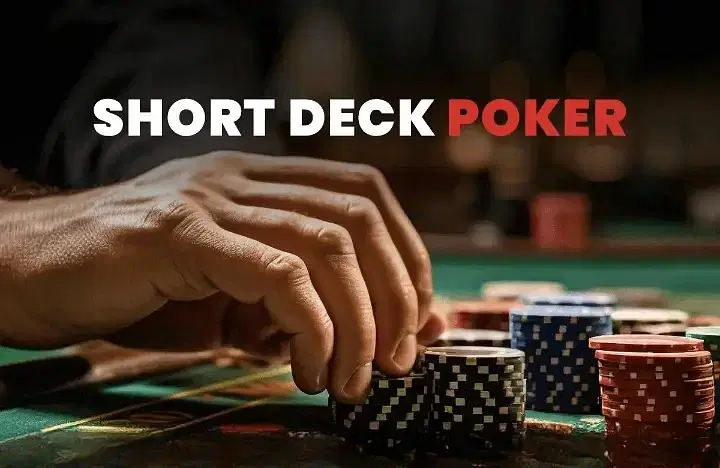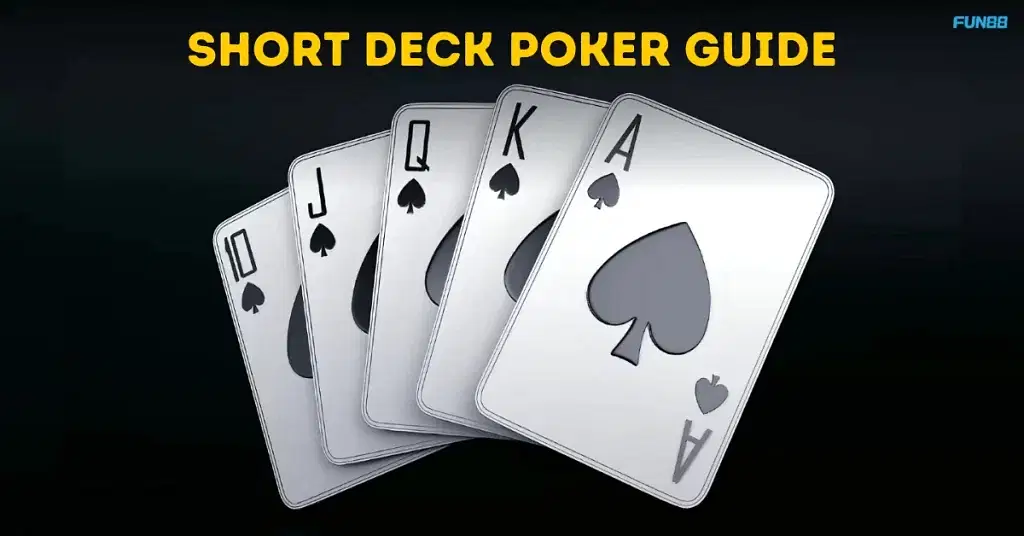Poker is an interesting card game that blends strategy and luck. One of the latest trends in the Poker scene is Short Deck Poker, a variation that has quickly gained traction and sparked the curiosity of both beginners and seasoned players alike. This guide explores the ins and outs of Short Deck Poker, taking you through the Short Deck Poker rules and helping you understand what makes this game so captivating.
What is Short Deck Poker?
Short Deck Poker, also known as Six Plus Hold’em, is a variant that modifies the traditional setup to introduce a faster pace and increased action. But what exactly makes it different from Texas Hold’em? The answer lies in the deck itself.
In Poker Game, the lower cards, specifically the 2s, 3s, 4s, and 5s, are removed from the deck, leaving just 36 cards (from 6 to the Ace). This alteration changes the probabilities and fundamentally affects hand strengths and strategies, creating a fresh experience for players accustomed to traditional Poker games.
The appeal of Short Deck Poker goes beyond the modified deck. It’s a game that challenges players to rethink standard Poker logic, experiment with new strategies, and adapt to different odds.
Basic Rules of Short Deck Poker

Understanding the Short Deck Poker rules involves knowing its similarities and differences from traditional Texas Hold’em. Here’s a detailed look at how the game unfolds:
- Ante and Blinds: While traditional Poker games start with small and big blinds, Short Deck often employs an ante system. Every player contributes an ante to the pot, and the player in the dealer’s position posts a “button blind,” which is an additional nominal blind bet.
- Dealing the Cards: Each player receives two hole cards, dealt face down. The objective remains to make the best possible five-card hand using any combination of hole cards and the five community cards.
- Community Cards and Betting Rounds: Just like in Texas Hold’em, the game proceeds with the familiar sequence of flop, turn, and river. These are stages where community cards are revealed, with wagering rounds in between.
- Betting Structure: Short Deck Poker is commonly played as a no-limit, allowing players to bet any amount of their remaining chips at any time. This format promotes thrilling action and strategic depth.
Dynamics of Action
The smaller deck results in more frequent big hands, increasing the frequency of strong hands like straights and flushes. The wagering excitement is accompanied by the constant need for quick strategic thinking. Players often find that hands they would fold in traditional Poker may be worthwhile pursuits in Short Deck, given the changed probabilities and the likelihood of more substantial pots.
Short Deck Poker Hand Rankings: What You Need to Know?
In Short Deck Poker, due to the absence of low cards, traditional hand rankings get a twist. Here’s how they differ from the standard deck order:
| Hand Ranking | Short Deck Poker | Traditional Poker | Explanation |
| 1. Royal Flush | Highest | Highest | Remains the strongest hand in both variants. |
| 2. Straight Flush | Second Highest | Second Highest | Consists of five consecutive cards of the same suit. |
| 3. Four of a Kind | Third Highest | Third Highest | Four cards of the same rank. |
| 4. Full House | Fourth Highest | Fourth Highest | Three of a kind plus a pair. |
| 5. Flush | Lower ranking than a Straight in Short Deck | Higher ranking than a Straight in Standard | Flushes occur more often in Short Deck; therefore, they are ranked lower. |
| 6. Straight | Higher ranking than a Flush in Short Deck | Lower ranking than a Flush in Standard | Straights are rarer in Short Deck, making them more valuable. |
| 7. Three of a Kind | Seventh Highest | Seventh Highest | Remains the same in both variants. |
| 8. Two Pair | Lower ranking | Lower ranking | Same rank in both, but easier to form in Short Deck. |
| 9. One Pair | Lower ranking | Lower ranking | Same rank in both variants. |
| 10. High Card | Lowest | Lowest | The weakest hand in both formats. |
Key Differences in Rankings
- Straight Beats a Flush: This is a reversal of the standard Poker rankings. The reasoning lies in probability; in Short Deck Poker, flushes are more common due to the reduced number of cards, making straights rarer and more valuable.
- Nuanced Values: It is vital to recognise the relative scarcity of particular hands compared to their traditional counterparts. While flushes might seem strong, they’re often outdone by straights and can fail against hands like a full house or four of a kind.
Understanding these adapted rankings is crucial when planning your Short Deck strategies and calculating your odds relative to opponents’ hands.
How to Play Short Deck Poker?

Understanding the unique dynamics of Short Deck Poker is essential for any Poker enthusiast. Here, we break down the essentials for getting started:
Short Deck Poker, known for its fast-paced action, uses a deck missing the low cards 2 through 5. Resultantly, players deal with cards ranging from 6 to Ace, making this version distinct in its persona. Familiarising yourself with these Short Deck Poker rules explained, you will first notice the change in hand values and Short Deck Poker hand rankings that heighten the stakes of every round.
The setup feels familiar to those accustomed to Texas Hold’em as players receive two hole cards, and five community cards follow the standard flop, turn, and river sequence. But pay attention to the subtleties in this layout. Observant players leverage their knowledge of adjusted Short deck Poker probabilities to make informed decisions, ultimately developing strategies based on this unique environment.
Next, understand that contrary to Texas Hold’em, the Short Deck Poker card removal increases the chance of higher-valued hands, fundamentally shifting your approach.
For instance, flushes are more frequent, and a straight often beats a flush. Recognising these nuances prepares players to plot their course successfully.
Also Read: Straddle in Poker: Know When to Use and Avoid It
Winning Tips for Short Deck Poker
Before diving into gameplay, absorb some crucial pointers:
- Evaluate Your Hands: While familiarising yourself with the best hands in Short Deck Poker, persistent evaluation and adjustment is crucial. Develop familiarity with advanced Short Deck Poker techniques.
- Adopt Flexible Strategies: Implementing flexible, adaptable Short deck Poker strategy developments ensures competitiveness throughout ever-changing tables.
After grasping the essential gameplay, you will soon be ready to explore how the wagering structure further enhances the depth of this exciting game.
Short Deck Poker Betting Structure Explained
You need to understand the financial framework of Short Deck Poker to appreciate how it builds its unique tension and excitement.
Unlike the Texas Hold’em traditional Poker blinds, Short deck Poker betting structure incorporates an ante system. This format sees each player contributing an initial pot share, guaranteeing higher stakes from the start. Furthermore, the dealer often places a “button blind,” a supplemental bet fostering action and engagement early in the round.
Placing your bets progresses without restrictions under a no-limit format. The opponent savours the chance to bet any percentage of their stack across each dealing phase. Such Short Deck Poker odds and strategic interactions compel seasoned participants to master bankroll management, composed wagering, and psychological pressures from aggressive opponents.
Finally, Short Deck Poker odds may be computed differently. With fewer cards in play, probabilities demand constant focus. Estimating the winning likelihood with fluctuating chips builds sharper attentiveness, vital for those adjusting from Texas Hold’em traditional framework. Grasping these economic details solidifies a player’s standing in competitive Short Deck ring
Also Read: How to Play 3 Card Poker: 12 Expert Tips to Play Smart
Differences Between Short Deck and Texas Hold’em
Understanding the contrasts between Texas Hold’em vs Short Deck Poker will ensure your strategy aligns with this vibrant variant.
The major difference is in deck size, Texas Hold’em uses 52 card decks and Short Deck Poker uses only 36 cards, impacting the hand rankings. Due to this distinction, players in Short Deck Poker get a higher frequency of strong hands, which speeds up the pace of the game and demands versatile strategies.
Additionally, Texas Hold’em involves intricate calculations based on a broader range of hands, Short Deck Poker requires players to adapt quickly to the unique probabilities presented due to the smaller deck, making it a game that challenges conventional Poker logic.
Short Deck Poker Strategy for Beginners
Understanding Short Deck Poker may seem daunting at first, but with the right Short Deck Poker tips for beginners, you can dive into this exciting variant confidently. Here’s what you need to know:
- Understand the Basics: Familiarise yourself with Short Deck Poker rules explained clearly to ensure you fully grasp differences like hand rankings and card removal. Knowledge of how Short Deck Poker hand rankings vary from traditional Poker is foundational.
- Start with Solid Hands: Focus on the best hands in Short Deck Poker, like high pairs or suited connectors, which hold immense value in this format. Strong hands in the start reduce risk.
- Adjust Strategies Rapidly: Transition from strategies used in Texas Hold’em vs Short Deck Poker requires quick adapting to new styles and flexibility.
- Manage Your Bankroll: Settle into a sustainable Short Deck Poker betting structure, crucial for long-term participation. This discipline protects newer players from significant losses amidst initial trials.
- Play to Experience: Take advantage of Short Deck Poker online options for practice. Virtual platforms like Fun88 acclimate you to different table dynamics and paces, reinforcing your understanding.
Advanced Strategies for Short Deck Poker

Once you’ve established a strong foundation in this game, employing advanced Short Deck Poker techniques becomes essential for taking the gameplay to the next level:
- Examine the Board’s Texture: Always relate community cards to your hand’s strength. Devise strategies around Short Deck Poker probabilities, calculating the likely outcomes from seen and unseen cards.
- Master Positional Play: Utilise your table position by varying your strategy based on the order of play, maximising opportunities with better positioning during rounds.
- Read Opponents: Observation helps you understand the opponents’ tendencies while reducing predictability in your tactics—a sure precursor to overall success.
- Incorporate Balanced Aggression: When appropriate, utilise aggressive gameplay, leveraging winning tips for Short Deck Poker by applying pressure and seizing control.
- Adapt Odds Calculations: Continuously update Short Deck Poker odds to develop advanced insights and responses, a hallmark of seasoned decision-making skills.
Related Read: Turn Poker Positions Into Winning Moves—Here’s How!
Probability and Odds in Short Deck Poker
Short Deck Poker’s unique format requires an understanding of specialised Short Deck Poker probabilities and odds. The altered deck composition dramatically impacts hand strength distribution, necessitating a reformed outlook.
Short Deck Poker card removal results in revised probabilities for hitting substantial hands like straights and pairs, often occurring more frequently than in Texas Hold’em. A quick assessment of board dynamics through careful calculation empowers well-informed wager decisions.
The reduced card count also results in closer equity between hands, prompting meticulous tracking of potential outcomes and testing old assumptions. Strong players actively utilise resources that provide Short Deck Poker odds knowledge, ensuring calculations remain sharp and continuously refined throughout gameplay.
Variants of Short Deck Poker: What’s Out There?
As Short Deck Poker’s popularity has risen, different playing styles and structures have emerged, adding enjoyable diversity to this engaging variant. Here’s an overview:
- Classic Short Deck: Retains foundational elements; widely embraced across traditional settings.
- Short Deck with Antes: Implements ante structures within tables, generating larger initial pots than standard blind formats.
- Limit and Pot-Limit Variations: Diversifies financial control during gameplay, offering distinct experiences beyond standard no-limit structures.
- Online and Tournament Adaptations: Fun88 enables players to play Short Deck Poker online, easily participating in worldwide Short Deck Poker tournaments.
Common Mistakes to Avoid in Short Deck Poker
Embracing Short Deck Poker strategy is key, but even seasoned players can falter. Avoid these pitfalls:
- Misunderstanding Hand Rankings: An inadequate grasp of Short Deck Poker hand rankings can lead to costly errors. With a thorough understanding, economic losses are avoidable.
- Overvaluing Hands: Higher frequencies of strong hands can attract players into overestimating. Short Deck Poker card removal means adjusted expectations are crucial.
- Ignoring Position Dynamics: Ignoring position leads to missed opportunities; awareness always guides informed decisions.
- Inflexible Game Plans: Rigid strategies fail in dynamic settings; adaptive tactics succeed in unpredictable conditions.
- Neglecting Probability Insights: Short Deck Poker probabilities heavily influence choices—consistently overlooking odds results in missed winning opportunities.
Frequently Asked Questions (FAQs)
The Royal Flush remains premium among the best hands in Short Deck Poker. However, straights gain significance as they outrank flushes. For accuracy, always assess Short Deck Poker rules explained in context.
Reduced deck counts alter likelihoods, making certain hands more common and impactful. Calculating Short Deck Poker odds differently is crucial for adaptability in both strategy formulation and execution.
Indeed, there are strategic differences between the two formats. Cash games welcome flexible methods, whereas Short Deck Poker tournaments emphasise calculated risks and progression. Adapt advanced Short Deck Poker techniques based on event types.
Complexity varies individually; while smaller decks simplify certain aspects, understanding probability shifts and mastering adaptability may pose challenges. This variant can be perceived as easier or more complex depending on prior experience and adaptability style.
Star it if you find it helpful.

